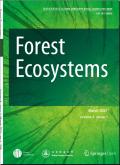Size heterogeneity, growth dominance development, and relationships with stand growth in unthinned and thinned loblolly pine plantations
IF 4.4
1区 农林科学
Q1 FORESTRY
引用次数: 0
Abstract
This study examined size inequality and size-growth relationships as essential aspects of stand structure in loblolly pine plantations (Pinus taeda L.), particularly focusing on a critical stage with strong competition from mid-rotation to rotation age and changes due to thinning. Data were from a loblolly pine thinning study of multiple sites in the western Gulf region, USA, which were thinned around age 14. Four treatments were evaluated: three thinning intensities (TIs: residual densities of 740, 555, and 370 trees·ha−1) and an unthinned control. An operational thinning method was implemented, involving the removal of every fifth row and selective thinning from below to achieve the desired intensity. The Gini index (GI) for diameter at breast height (DBH), height (H), and volume was computed annually for the first five years since thinning and at year seven, while growth dominance (GD) of these traits was calculated by growth interval. The control exhibited increasing trends over the year in GIs and greater inequality in DBH compared to height (GI = 0.10 vs. 0.04), and thinning reduced both GIs. Competition for DBH growth in the control was weakly asymmetric (GD = 0.06), and thinning decreased GD, fostering weaker asymmetric competitive environments. The control displayed reverse asymmetric competition for height (GD = −0.10), and thinning strengthened reverse dominance. The thinning effects on reducing GIs and GD increased with TI. The observed patterns of competition appear to stem from adaptive resource allocation strategies rather than being influenced by neighboring tree sizes. The tree volume (VOLT)-based GI and GD might overestimate size inequality for DBH or height, and misinterpret GD for height. Stand volume growth in the control is linearly related to GD, being negative for DBH and positive for height, indicating GD offers valuable insights into stand growth dynamics. Thinning did not change the relationships but slowed the rates of change. The decline in stand growth associated with reduced DBH GD by thinning suggests that GD itself may not be the primary causal factor behind growth changes by thinning.
未疏伐和疏伐火炬松人工林大小异质性、生长优势发展及其与林分生长的关系
本研究考察了火炬松人工林林分结构的大小不平等和大小-生长关系,特别关注了轮作中期到轮作年龄这一竞争激烈的关键阶段以及间伐引起的变化。数据来自美国西部海湾地区多个地点的火炬松间伐研究,这些火炬松在14岁左右被间伐。评估了四种处理:三种间伐强度(ti:剩余密度为740、555和370棵·ha−1)和一种不间伐的对照。实施了一种可操作的减薄方法,包括每隔第五行去除一次,并从下面选择性地减薄以达到所需的强度。胸径(DBH)、高度(H)和体积的基尼系数(GI)分别在伐后前5年和第7年每年计算一次,而这些性状的生长优势度(GD)按生长间隔计算。对照在GIs中呈现逐年增加的趋势,胸径与高度之间的不平等更大(GI = 0.10 vs. 0.04),间伐降低了这两个GIs。对照中胸径生长竞争呈弱不对称(GD = 0.06),疏林降低了GD,形成了弱不对称竞争环境。对照表现为身高的反向不对称竞争(GD =−0.10),变薄强化了反向优势。随着TI的增加,稀释对降低gi和GD的作用增强。观察到的竞争模式似乎源于适应性资源分配策略,而不是受邻近树大小的影响。基于树体积(VOLT)的GI和GD可能会高估胸径或高度的大小不平等,而误解GD对高度的影响。对照林分体积增长与GD呈线性相关,胸径为负,高度为正,表明GD为林分生长动态提供了有价值的见解。变薄并没有改变这种关系,但减缓了变化的速度。林分生长的下降与林分胸径GD的降低有关,这表明GD本身可能不是林分胸径GD变化的主要原因。
本文章由计算机程序翻译,如有差异,请以英文原文为准。
求助全文
约1分钟内获得全文
求助全文
来源期刊

Forest Ecosystems
Environmental Science-Nature and Landscape Conservation
CiteScore
7.10
自引率
4.90%
发文量
1115
审稿时长
22 days
期刊介绍:
Forest Ecosystems is an open access, peer-reviewed journal publishing scientific communications from any discipline that can provide interesting contributions about the structure and dynamics of "natural" and "domesticated" forest ecosystems, and their services to people. The journal welcomes innovative science as well as application oriented work that will enhance understanding of woody plant communities. Very specific studies are welcome if they are part of a thematic series that provides some holistic perspective that is of general interest.
 求助内容:
求助内容: 应助结果提醒方式:
应助结果提醒方式:


